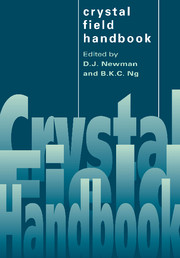Book contents
- Frontmatter
- Contents
- List of contributors
- Preface
- Introduction
- 1 Crystal field splitting mechanisms
- 2 Empirical crystal fields
- 3 Fitting crystal field parameters
- 4 Lanthanide and actinide optical spectra
- 5 Superposition model
- 6 Effects of electron correlation on crystal field splittings
- 7 Ground state splittings in S-state ions
- 8 Invariants and moments
- 9 Semiclassical model
- 10 Transition intensities
- Appendix 1 Point symmetry
- Appendix 2 QBASIC programs
- Appendix 3 Accessible program packages
- Appendix 4 Computer package CST
- Bibliography
- Index
Appendix 4 - Computer package CST
Published online by Cambridge University Press: 10 December 2009
- Frontmatter
- Contents
- List of contributors
- Preface
- Introduction
- 1 Crystal field splitting mechanisms
- 2 Empirical crystal fields
- 3 Fitting crystal field parameters
- 4 Lanthanide and actinide optical spectra
- 5 Superposition model
- 6 Effects of electron correlation on crystal field splittings
- 7 Ground state splittings in S-state ions
- 8 Invariants and moments
- 9 Semiclassical model
- 10 Transition intensities
- Appendix 1 Point symmetry
- Appendix 2 QBASIC programs
- Appendix 3 Accessible program packages
- Appendix 4 Computer package CST
- Bibliography
- Index
Summary
The intrinsic physical properties of the crystal field Hamiltonian have led over the years to various formats and conventions being used in the literature to express crystal field parameters. Hence comparison of crystal field parameter sets from various sources often requires several manipulations and conversions. To facilitate the computations involved in this process, the user-friendly computer package ‘CST’ (Conversion, Standardization and Transformation) has been developed [RAM98, RAM97]. The package is useful for various general manipulations of the format of the experimental zero-field splitting parameters as well as the crystal field ones. Its capabilities include CONVERSIONS: unit conversions – between several units most often used for crystal field and zero-field splitting parameters; normalization (or notation) conversions – between several major normalizations for crystal field and zero-field splitting parameters; STANDARDIZATION of orthorhombic, monoclinic and triclinic crystal field and zero-field splitting parameters; and TRANSFORMATIONS of crystal field and zero-field splitting parameters into an arbitrary axis system, including the rotation invariants.
In this appendix the structure and capabilities of the CST package are briefly presented. In keeping with the overall approach of a book designed as a ‘Do-It-Yourself’ text, the emphasis is put on the practical implementations of the package, illustrated using examples of experimental data taken from recent crystal field literature. A detailed description of the CST modules is provided in the Manual [RAM97], whereas examples of applications to zero-field splitting parameters are dealt with in [RAM97, Rud97, RM99].
- Type
- Chapter
- Information
- Crystal Field Handbook , pp. 259 - 268Publisher: Cambridge University PressPrint publication year: 2000
- 15
- Cited by



